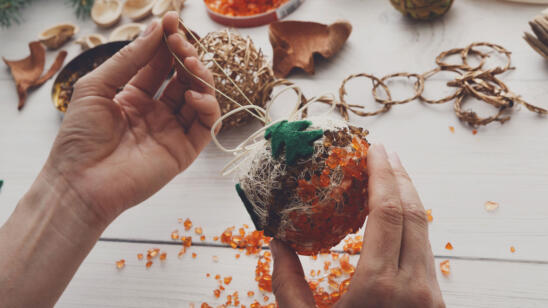Ever wonder why everything “smells like Christmas” over the holidays? Very specific spices come out toward the end of the year, and they’re quite essential in the way we experience traditional dishes at home and in restaurants. While the holidays have distinct sights and sounds, these particular spices truly lead the senses to that iconic holiday spirit.
Nutmeg
Perhaps the most famous holiday spice, nutmeg is the kernel of the fruit of tropical evergreen trees. It works wonders for traditional holiday recipes, especially cookies, pies and eggnog, due to its harmonious relationship with dairy. Earthy, nutty and with a hint of sweetness, nutmeg is mostly used freshly grated or milled and can be sprinkled on savory dishes like potatoes, eggs and meats. It’s a high-mineral spice (containing magnesium, potassium and zinc), which has made it a great home remedy for relaxation and sleep. No wonder eggnog helps soothe homes during the holidays!
Cinnamon
With its myriad of uses and powerful flavor, cinnamon is commonly used year-round but it truly shines throughout the holidays. The crowd-pleasing, sweet spice (from the aromatic bark of a tree native to India and Sri Lanka) can enhance flavors of fruit like apples and pears, and it’s a traditional spice used in sugary treats like gingerbread, pumpkin pie and cakes. Add cinnamon to sweet potato and curries over the holidays and you’ll definitely want seconds. Typically ground, cinnamon is particularly known for its warming scent, which is why it’s common as a fragrance in candles and home sprays.
Clove
This ancient spice native to Indonesia has been around for thousands of years, including recipes that are still used today. Clove has a warm, sweet and slightly bitter taste, and it’s hugely versatile. It can flavor meats and stews, rich sauces and plenty of desserts like pies. Clove is traditionally ground to enhance the taste of gingerbread and fruitcake over the holidays, though they are also used whole to flavor a dish like glazed ham or basmati rice. It’s one of the richest sources of antioxidants and a great source of fiber, so expect many health benefits like digestion and anti-inflammatory qualities.
Ginger
One of the most prominent health boosters in the kitchen, ginger is technically an herb but commonly known as a spice, and it’s been used by the Chinese for thousands of years as medicine! It has multiple health benefits (including reducing fevers, calming upset stomachs, etc), which is why it’s often found in tea and many Asian dishes. Whether dried or ground, ginger has a warm and woody flavor, and is responsible for making gingerbread cookies and cakes as delicious as they are.
Allspice
Allspice was originally thought to be a combination of many spices like cinnamon, nutmeg and clove, which is how its name originated. It really is just one spice: the dried berry of the Jamaican pimento tree. Loaded with Vitamin C, allspice is frequently used like cinnamon and nutmeg in cookies, cakes and breads (notably gingerbread). It also adds a surprising amount of depth and a warm flavor to savory dishes like pork loin and butternut squash soup, and it’s a main ingredient in jerk seasoning.
Peppermint
A favorite for children and adults alike, peppermint is the signature scent of Christmas. It’s particularly celebrated with the holiday-themed candy cane, which has had the peppermint flavor for almost 600 years. This holiday spice that’s cooling, minty and sweet is prominent in teas and coffees over the wintertime thanks to its main active agent, menthol. Peppermint helps with colds and sore throats, but it’s ever-present in almost everything Christmas, especially in sweet treats like filling in cakes, crumbled on top of cookies and, of course, flavoring candy.


